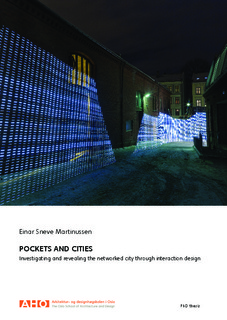Pockets and cities : investegating and revealing the networked city through interaction design
Doctoral thesis, Peer reviewed
Permanent lenke
http://hdl.handle.net/11250/2419331Utgivelsesdato
2015Metadata
Vis full innførselSamlinger
- Design [33]
Sammendrag
This thesis is about investigating and revealing the networked city through interaction design. The ‘networked city’ describes the interweaving of digital, networked technologies with the urban landscape and everyday city life. The networked city has become a prominent topic in recent years across academia and industry, and is making its mark on daily life. Networked city life is enacted through wireless networks, satellite navigation, and ever-more sophisticated mobile devices, while the discourses of emerging technologies in cites are dominated by technology-led visions of the ‘smart city’ (Greenfield, 2013).
In this thesis I address these issues through practice-led interaction design research that seeks to explore, visualise, and communicate the technological and cultural invisibilities of the networked city. This project comes out of a collaborative project- and design-based practice. It is a ‘research-by-design’ project that draws together an interdisciplinary frame spanning interaction design, urbanism, and theories of everyday life and culture. In this project I pursue an explorative, reflexive design research practice that seeks to visualise and communicate emerging technologies in cities. The thesis addresses two connected research questions: first, how can the often invisible, technical structures of networked city life be investigated and made visible through interaction design? And how might practices of explorative and communicative interaction design contribute to new perspectives on the emergent networked city? These questions are further part of the research challenge of developing an analytical position on the networked city and interaction design situated in everyday life and culture.
The design, development, and dissemination of a film series titled Immaterialsplays a central part in the research practice of this thesis. The Immaterials series was produced by myself and a small team of interaction design researchers. In this series of online films we investigate and visualise three common, yet invisible, urban technologies: RFID, WiFi, and GPS. With the Immaterials films, tools and approaches from interaction design were used for doing technical, material investigations of technology, and further turning these investigations into communicative and discursive artefacts for engaging with the popular cultural understanding of technologies. The films and artefacts produced in this thesis therefore have a dual analytical and methodological function; they are a means for revealing the networked city, and catalysts for a wider cultural discussion of the role of emerging technologies in urban life.
Through the practice of this thesis I illustrate and argue for an expanded view of interaction design that is not limited to issues of technology and use, but that explores how technologies are understood culturally. Interaction design is here approached in a discursive and cultural frame, where the tools and methods of the discipline are put to use for navigating, translating, and engaging between and across technology, materials, and media. We have termed this a ‘discursive design’ approach that uses the languages and techniques of design to explore and communicate complex technological issues, and to promote discourse, critique, and invention.
In this project, analysis is threaded through a reflective design research practice. Alongside the body of the design work, I have identified and developed a set of themes for analysing the relationships between interaction design and the networked city. These are informed by the practice-led interaction design research, alongside interdisciplinary analysis that draws together concepts from interaction design and networked urbanism with theories of everyday life and culture studies. Together, the thematics work towards developing an analytical position on the networked city and interaction design. This analytical positioning situates these fields in relation to both everyday life and to the cultural materials and expressions that accompany new technologies into daily practices. This is further connected to how design can contribute to these cultural materials through discursive, mediated artefacts such as online films.
With this thesis, I make contributions on three main levels. I develop analytical themes and discussions that investigate the relationships between the networked city, interaction design, and daily urban life. Through the practice-led research, I also develop examples of how interaction design can be used for contributing to, and stirring, popular cultural discourses of technology.
Finally, through this project I have created and communicated a body of design work that in itself contributes to the imagery of networked city life.
